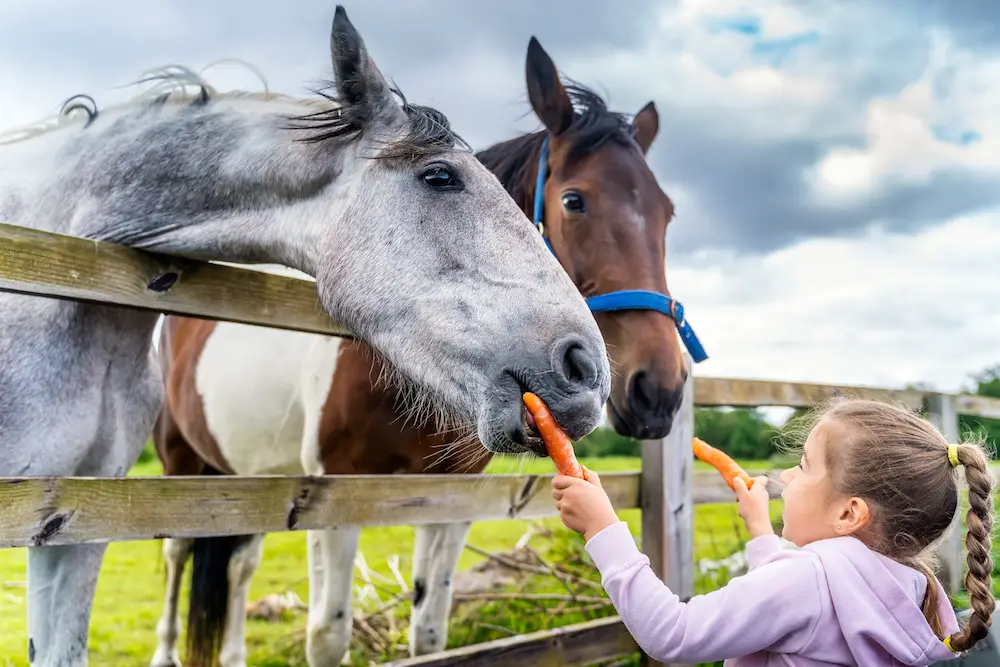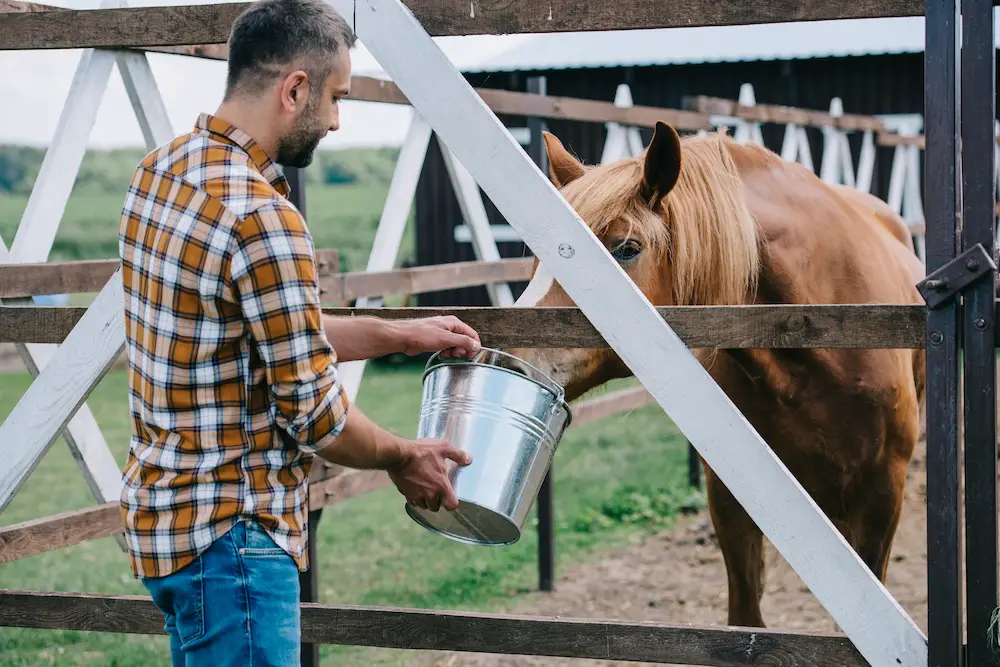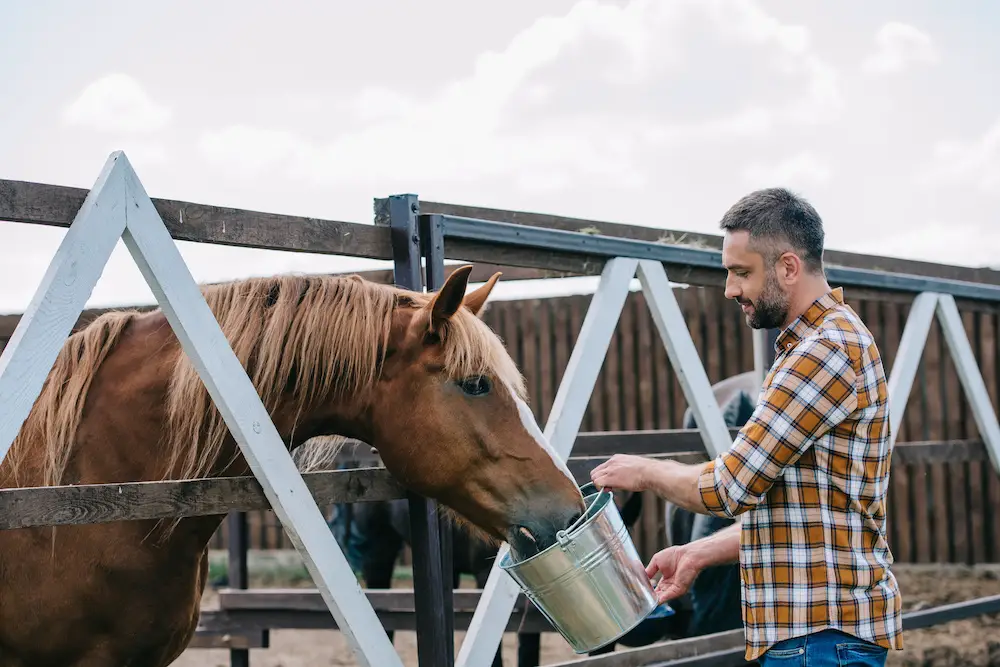There isn’t much that can surpass the excitement one feels over getting a new horse.
However, before it even arrives, you will want to educate yourself on a horse’s proper feeding requirements.
Like any living being, horses need to eat a balanced diet to function well and remain in good shape.
So, how much does a horse eat?
Several factors play a part in knowing exactly how much. Hence, we prepared a complete guide you can use to nourish your horse correctly.
How Much Does a Horse Eat?
For a new owner, it is easy to assume that you can feed a horse anything endlessly.
After all, we learned from school that they spend almost 16 to 19 hours a day munching.
In figuring out how much to feed your horse, you have to keep in mind that a lot of factors affect it.
First of all, horses vary according to size and can have different activity levels.
In a nutshell, you will want to feed your hose about 1.5 to two percent of their body weight.
The percentage will depend on the horse’s activity levels and metabolism.
A horse who has trouble keeping its weight can go for two percent. On the other hand, horses that don’t have much activity can go for 1.5 percent and more.
Here is a rough estimate:
- 5 percent of a 1000-pound horse = 15 kg/day
- 2 percent of a 1100-pound horse = 22 kg/day
How to Get Your Horse’s Body Weight
As mentioned, knowing your horse’s weight is vital to determining the amount of food they need in a day.
If you have no idea how to take it, here are a couple of ways you can do it.
Tape Method
If the only available method for measuring your horse is a weight tape, go ahead and get its girth and height.
Weight tapes are available in different shops if you want to purchase them.
To use it, start by measuring around the horse’s girth and over its body until you reach the back portion of its withers.
Once you have the values, you can use these formulas to get their estimated weight.
- Adult Horse Weight (lbs.) = girth x girth x body length/300
- Pony Weight (lbs.) = girth x girth x body length / 299
- Yearling Weight (lbs.) = girth x girth x body length / 301
- Weanling Weight (lbs.) = girth x girth x body length / 280
Scale Method
You can use different types of scales to measure your horses, but make sure it is well-calibrated.
Here are the weighing scales used to measure horses:
- Livestock Scale
Using a livestock scale is the ideal method of measuring a horse’s weight.
If you don’t own one, you can check out auction barns or veterinary clinics. These facilities often have these available.
- Truck Scale
If you are after accurate measurements, this is not the best way to do it.
A truck scale is not as well-calibrated as livestock scales.
Additionally, this method can be tiring because you have to load your horse onto the truck to weigh it.
Several factors, like the gear you have towed on the truck or the fuel loaded, can affect the results.

How a Horse’s Digestive System Work
To put it simply, a horse has a single stomach and can eat as much as sheep or cattle do.
However, their digestive system works differently and is more similar to human digestive function.
This difference means the feed interacts with pepsin and hydrochloric acid to break down food particles.
When you feed a horse, the food goes into the stomach and moves to the small intestine.
This area is the part that digests and absorbs most protein, carbohydrates, and sugars.
Then, it moves to the large intestine, which has millions of microorganisms responsible for breaking down fibrous content.
The process continues to the large colon, where fecal matter forms and water is absorbed.
From there, the food turns into waste that eventually passes the rectum.
Overfeeding
Unlike other animals, most horses don’t have self-control when it comes to food.
When you give them an unlimited food supply, they will continue to munch endlessly.
If this continues, your horse will end up obese, overweight, and overfed.
A horse only uses 10 percent of its digestive capacity, which means you can only feed it in small amounts.
Not giving them food in small servings will result in the accumulation of hydrochloric acid.
Meanwhile, too much of this can lead to irritation of the lining and ulcers.
It is also worth noting that the passage rate increases when you feed horses a large volume with high soluble sugars.
The small intestine gets overwhelmed, leading to an overproduction of lactic acid and gas.
This occurrence leaves your horse with two of the most common equine problems: laminitis and colic.
Underfeeding
Meanwhile, giving it too little or less than what it needs can leave you with a malnourished one.
As a result, you will notice a lack of energy in your horse, and it will also be vulnerable to illnesses.
Getting the correct measurements and amount of food to give your horses is essential.
However, just as important is understanding how a horse’s digestion works.
This way, you will have more insight into what type of food to give them.
Achieving the Balance in Feeding
There are several methods to make sure you feed your horses well, but the goal is to give them a balanced diet.
Many get confused with how much forage and concentrate to mix in their horse’s diet.
If you are one of those horse owners, here is a quick guide that you can follow:
Forage
The term “forage” refers to grass and hay. It makes the bulk of a horse’s natural diet, even if it contains nettles, seeds, and other contents.
It is essential to feed your horses the highest quality pasture available, as this is where they mainly get their nutrition.
Those with high quality also have silica, which keeps the horse’s teeth in excellent condition.
Experts recommend having forage make at least 80 percent of a horse’s diet. However, you can adjust this depending on several factors.
If you have a horse on a pasture grazing grass at 20 to 30 percent dry matter (70 to 80 percent moisture), it will need a substantially higher intake.
Your horse will require roughly 30 to 60 pounds daily because of the pasture’s extra moisture.
A horse at maintenance or doing light work needs quality forage only.
For this type of horse, you will need 50 percent of good quality forage. It would be best if you give it high levels of forage for better gut motility.
Meanwhile, a horse who is always on the move or doing intense work will need more concentrates for energy.
Even so, it does not eliminate the need for forage.
Note that giving low levels of forage and high levels of concentrates can lead to diarrhea and digestive problems.
To give you a better idea of how to manage the amount of forage to include in your horse’s diet, here is a simple guide:
- Maintenance Horse with one to two percent of body weight: 50 to 100 percent of forage
- Pregnant Mare with one to two percent of body weight: 50 to 85 percent of forage
- Early Lactating Mare with one to 2.5 percent of body weight: 33 to 85 percent of forage
- Late Lactating Mare with one to two percent of body weight: 20 to 60 percent of forage
- Weanling Horse with 0.5 to 1.8 percent of body weight: 30 to 65 percent of forage
- Yearling Horse with one to 2.5 percent of body weight: 33 to 80 percent of forage
- Performance Horse with one to two percent of body weight: 33 to 80 percent of forage
Concentrate
To make the remaining 20 percent of your horse’s diet, you will need to throw in some concentrates.
A concentrate can be in the form of a pre-made mixture, pellet, or something else you can add to your horse’s diet.
- Pre-mixed
This mixture comprises various components: bran, flaxseed, beet pulp, grains, molasses, minerals, and vitamins.
You can buy pre-mixed concentrate feeds already mixed following a specific recipe.
If you have many horses to feed, specific feed mills can mix it specifically for you and your specifications.
- Pellets
Compressed corn, salts, vitamins, and other grains usually make up pellets.
As an added benefit, it also has molasses that act as a sweetener and a binder.
Pellets can be prepared specifically for pregnant mares, foals, performance horses, and elderly horses.
- Loose
This type of concentrate gives you complete control of your pet’s diet.
You are not limited to purchasing pre-mixed and pellets. Instead, you can mix all the ingredients on your own.
The downside of this is that you have to adjust the ratio on your own if the outcome isn’t that good.

What to Remember When Feeding Your Horse
Knowing how much to feed your horse is just the first of many steps you’ll have to learn.
To give you even more advice, here are the best practices to follow when feeding your horse:
1. Go for frequent small feedings for grain.
If you feed your horse grain by any chance, you must know that it is best to go for frequent small feedings.
Most of the time, grain is given twice a day, but you may need additional feeding if you give your horse smaller quantities.
This way, your horse will develop better digestion.
Then again, horses have varying needs in terms of the amount of work it does and its size.
So, in case your horse shifts to a new work routine, make sure to adjust it as necessary.
2. Implement feeding or diet changes gradually.
It is easy for everyone to assume that horses are entirely similar to humans.
Indeed, they are like humans because they are sensitive to changes.
Sudden changes and differences in their feeding can result in founder or colic.
Hence, when changing their feeding schedules or feeding options, you’ll want to do it gradually.
It is vital to do changes in increments when increasing or decreasing their ratio size.
This change should be done little by little and, if possible, over several weeks.
The same applies when there is a need to change their feed type.
An excellent way to do this would be by replacing 25 percent of their current food with the new one every two days.
Ideally, you will be able to transition over to their new food in six days.
3. Be concise and consistent with feeding.
Always measure your horse’s food with the proper weighing methods.
You can decide how to measure it and use different scoops, spoons, and other measuring materials.
Doing this ensures that you are serving them the correct ratio size.
On the other hand, it is also good to weigh your horse from time to time to check if their diet still works.
With utmost certainty, their build will require a particular combination of feeds.
4. Practice proper feeding intervals and timing.
Most of the time, we get too thrilled about riding a horse that we forget about the basics.
Perhaps the most important is waiting an hour or more after feeding before riding your horse.
If you plan to engage in strenuous activities, it would be best to wait for three hours.
A horse with a full stomach can’t get its lungs to function well, especially during physical activity or exercise.
This is because most of the horse’s blood will be focused on digesting the food it just ate.
Engaging your horse in exercise right after feeding can cause health issues, like colic.
Thus, it’s also important to make sure that you let them rest and settle down before feeding them after a day’s work.
You will want their heart rates and breathing at a steady and stable pace.
5. Establish a routine.
Believe it or not, the internal clocks of horses are superb. It makes them excellent timekeepers and a devotee of routine.
That said, it is good to have a fixed and regular feeding routine for your horses.
While some can adapt to changes, most horses do not respond well to deviations in their routines.
A sudden change can cause them to feel frustrated and annoyed, so much so that a colic episode can occur.
6. Avoid giving supplements in excess.
Supplements are sometimes not needed if the horse has a well-balanced diet.
However, you can give this to a horse suffering from health conditions that developed from a lack of vitamins or minerals.
On the other hand, giving your horse many supplements can hurt too. Too much of this can cause minerals and vitamin imbalances.
The Takeaway
Figuring out how much does a horse eat may be easy for some, but new horse owners need to learn more than a few things.
In the end, though, the answer falls on a range of dependencies and variables.
The single most valuable takeaway from all this is that horses have different needs.
As such, you will have to adjust not only its feeding times and frequencies but also how much you feed it from time to time.
Fortunately, you now have our guide to ease you into doing it.

